Samsung Galaxy S 2 (International) Review - The Best, Redefined
by Brian Klug & Anand Lal Shimpi on September 11, 2011 11:06 AM EST- Posted in
- Smartphones
- Samsung
- Galaxy S II
- Exynos
- Mobile
The other part of the story is Samsung’s mobile Digital Natural Image engine, or mDNIe, profile set on the SGS2. Numerous people have noticed that under Display -> Background Effect, lurks a page with a sample image and three presets - Dynamic, Standard, and Movie.
On previous Galaxy S devices there was a box in the camera app marked ‘outdoor viewing’ which increased brightness and contrast. I always wondered how that worked, and the answer is through mDNIe profiles. Inside /system/etc/ are a bunch of files prefixed with ‘mdnie_tune’ and then some more text, for example ‘mdnie_tune_camera_outdoor_mode’ and ‘mdnie_tune_standard_mode’. Of course, these are how the various settings are defined, and there are a bunch of them.
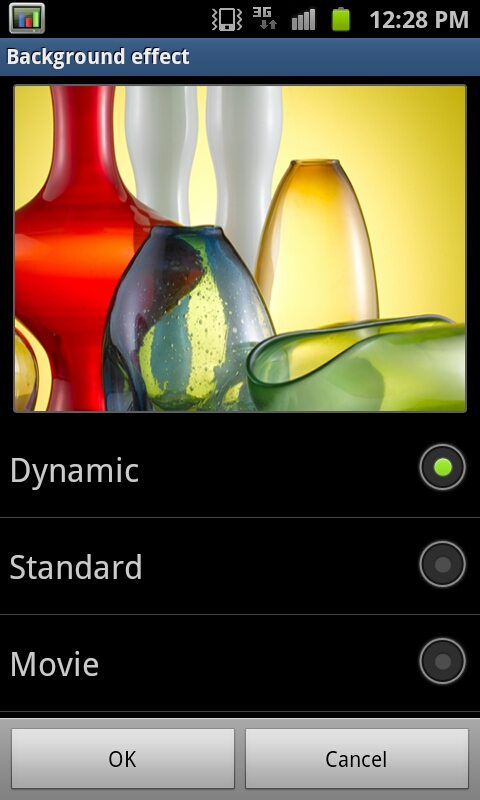
Inside are settings which control sharpening, saturation, and other things which are governed by mDNIe. For example, the mdnie_tune_ui_standard_mode file looks like this:
//start 0x0001,0x0000, // 0x002c,0x0fff, //DNR bypass 0x003C 0x002d,0x1900, //DNR bypass 0x0a08 0x002e,0x0000, //DNR bypass 0x1010 0x002f,0x0fff, //DNR bypass 0x0400 0x003A,0x000d, //HDTR DE_off CS : de on = d , de off = 9 0x003B,0x0001, //DE SHARPNESS(0~1023) off 0x003C,0x0000, //NOISE LEVEL 0x003F,0x001e, //CS GAIN 30 0x0042,0x0030, //DE TH (MAX DIFF) 0x0028,0x0000, //Register Mask //end
Movie and Standard just differ in CS (Chroma Saturation) Gain (from 30 to 50), and dynamic boosts that to 300 along with another field whose purpose I’m not certain of. I’m told by Francois that Dynamic also changes white point through mDNIe by clamping and thus results in some dynamic range being lost. Unfortunately there’s no - everything off - mode with no sharpening or chroma gain that makes colors less oversaturated out of the box, though if you have root obviously you can change and experiment with these. Now that we’ve mentioned it, all measurements I’ve done on the SGS2 were in the Standard mode.
Now what about brightness across the spectrum of user-selected intensity percentages?
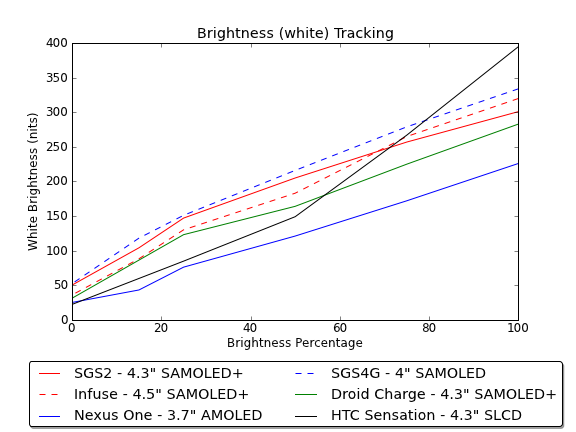
It’s redundant to show black brightness since each device measures 0 nits due to black pixels not emitting any light, so AMOLED remains super contrasty, even if brightness is about the same with SAMOLED+ as it was with SAMOLED. Thankfully the curve is nice and linear.
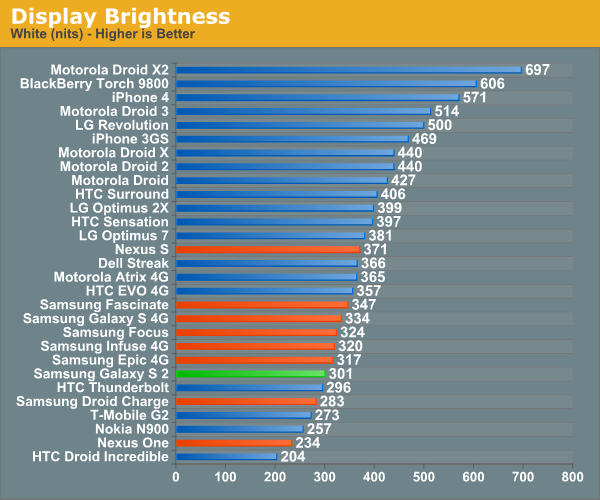
On the big display graph though, SAMOLED+ still isn’t as bright as the competition, though again having infinite contrast does make the display subjectively awesome indoors.
Outdoors SAMOLED+ is about the same as the previous generation. It isn’t very easy to see the display contents outside in direct sunlight, but then again what phone does look as good outside as it does inside? SAMOLED+ as mentioned earlier still leverages the optical bonding benefits (fewer reflections) that SAMOLED brought, so if you were pleased with view-ability there expect much of the same with this update.
The only major issue outdoors is something else entirely. I noticed pretty quickly with the Infuse 4G and Droid Charge that outside in my climate’s environment (~100+F outdoor temps, lots of sunlight) that the phones would clamp brightness to about 75% to prevent overheating. This is in part a measure to protect the display panel and of course other internal components. I set out to find out whether SGS2 implements the same thermal restrictions, and it does.
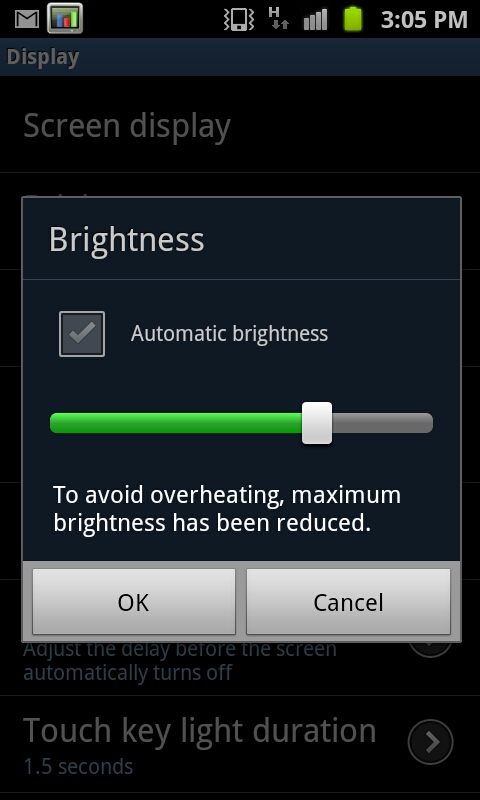
I broke out my contactless IR thermometer and went outside into the midday sun on my patio and set the phone down. Overheating and clamping down the display brightness doesn’t take long in this climate, about 5–10 minutes will do it. At around 115F (~45C) surface display temperature you’ll get clamped to 75% maximum until temperature drops down. I actually subjectively don’t think SGS2 is as prone to overheating as the Charge or Infuse.
Some other people have reported SGS2 crashing or encountering a thermal shutoff after a certain point, so I braved the heat and stayed outside even longer using the device until it hit well over 140F (60C) and still no system shutdown or overheating happened. That’s not to say it isn’t possible, as the SGS2 clearly does have thermal monitoring, for example the following lines from dmesg suggest some thermal monitoring going on, though I definitely crossed these boundaries to no ill effects:
<6>[ 0.047638] thr_low: 83, thr_high: 98 warn_low: 97 c warn_high 106 <6>[ 0.047715] tq0_signal_handle_init <6>[ 0.047751] tmu_initialize: te_temp = 0x00000048, low 8bit = 72,high 24 bit = 0 <6>[ 0.047765] Compensated Threshold: 0x7d <6>[ 0.098087] Cooling: 82c THD_TEMP:0x80: TRIG_LEV0: 0x89TRIG_LEV1: 0x99 TRIG_LEV2: 0xa0
Back to the display, next up are viewing angles, which the SGS2 thankfully preserves from the previous generation. I tossed the SGS2, SGS4G, and Optimus 2X in the lightbox and took pictures at various extreme angles. I realize the Sensation is a comparison point people are interested in, unfortunately that went back a while ago.
Viewing angles are awesome on all three - the SGS4G’s SAMOLED display (left), SGS2’s SAMOLED+ (middle), and Optimus 2X’s IPS display (right).
Another small thing about the SGS2’s SAMOLED+ is that I’ve noticed that high contrast images can be persistent for a few seconds. It isn’t burn-in, but a persistence that stays for a few seconds and can be very visible. For example, leaving the Android keyboard up (which is black, grey, and white) and dragging the shade down, a shadow of the keyboard remains visible until it fades after a few seconds. This persists even on other applications as well, and I can only hope doesn’t become something permanent if left up too long.
Wrapping up SAMOLED+ is difficult, because whether or not you like it over traditional LCD alternatives is ultimately a very subjective (and as I’ve learned in discussions, sensitive) matter. We’ve codified the differences between SAMOLED+ and previous generations, and other IPS displays, but really it’s impossible to communicate every subtle difference.
Personally, I prefer higher PPI IPS-LCD displays, though at 4.3“ SAMOLED+’s WVGA (800x480) isn’t a slouch, and the change from RGBG PenTile to an RGB stripe helps matters. Where WVGA starts to become a problem is at 4.5”. Scaling up area and increasing the diagonal size by 0.2“ doesn’t sound like a problem, but r^2 is a bitch, and at that size both the Android UI elements and subpixels look absurdly huge. Luckily, the international SGS2’s 4.3” is completely tolerable with WVGA.
MHL
Last but not least, the SGS2 supports HDMI out through USB MHL. For those that haven’t encountered the term before, MHL (Mobile High definition Link) is just a way of getting HDMI out through a low pin-count port alongside supplying power. So far, all MHL I’ve seen has worked over microUSB, but other interfaces possibly may support MHL in the future as well.
I had a Samsung MHL adapter laying around from a Samsung Infuse 4G, which has a microUSB port on the side for connecting to a charger, a full size HDMI port, and the microUSB connector which plugs into the host device. With all this connected, you can then get HDMI mirroring working, which does work on the SGS2.
I connected the SGS2 over HDMI up to an ASUS PA246Q and saw it negotiate a 1080i link and do HDMI mirroring flawlessly. Landscape is also supported, thankfully, and seems to work just like it should.


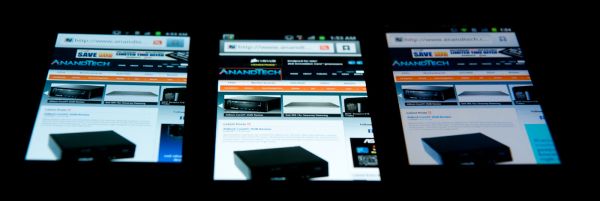






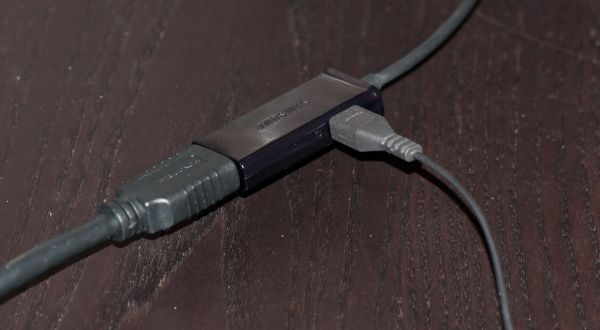
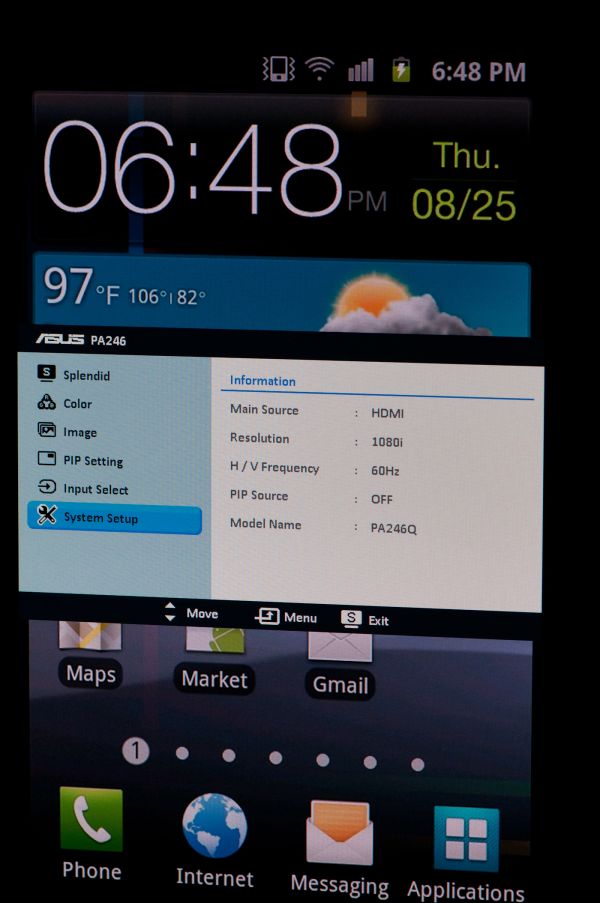








132 Comments
View All Comments
jcompagner - Monday, September 12, 2011 - link
When i am already using it for months and months now, and i am already thinking maybe next month or 2 i will replace it with its successor the Nexus Prime or what ever it may be called...Again here the complains about no updates.
What are you people complaining about, please...
Samsung releases, yes not officially but they are real samsung releases, quite often roms
for example here are the SGS2 once's:
http://www.samfirmware.com/WEBPROTECT-i9100.htm
A few releases per month, i am now on the latest one (2.3.4 of August 12)
If you look there to other phones you also will see many updates of all the latest phones of samsung.
So it is very easy and you dont need to root if you don't want to, just flash these roms. and you have a updated samsung made rom. (but yes 'leaked')
Reikon - Monday, September 12, 2011 - link
"Vellamo produces its scores directly from frame counters, so what you're looking at is a direct representation of how fast these devices scroll through the three web tests above. The Galaxy S II is 20 - 35% faster than the Photon 4G and 45 - 100% faster than the EVO 3D."You mixed up Photon 4G and EVO 3D, either in the table or the comment under it. The data shows the SGS2 20-35% faster than the EVO 3D and 45-100% faster than the Photon 4G.
Stormkroe - Saturday, September 17, 2011 - link
I thought I was the only one noticing this too. I'm also concerned with the adreno missing from the 2.1 off screen render tests, as well as pointing out that it would definitely be beating the S2 in GL 2.0 Pro if resolutions were normalized there. Feels like the whole thing was meant to really set the mali on a high horse. Don't get me wrong, I think it's great, just not "double the speed of the competition" when you throw the entire lineup in the mix.poohbear - Tuesday, September 13, 2011 - link
Nice to read this review finally, it is indeed an awesome piece of hardware. Im not even sure the iphone 5 will be able to compete? guess we'll find out next month!PWRuser - Tuesday, September 13, 2011 - link
Is the SGS2 memory the newer 30nm LPDDR2 1066 or the 800 one found in older phones?QWIKSTRIKE - Tuesday, September 13, 2011 - link
When will you do a Sprint review with CDMA antenna signal repsonsivenessOlrac - Tuesday, September 13, 2011 - link
Just for those who would like to know I am running The galaxy s2 overclocked to 1.6Ghz and its rock steady no crashes or freezes does not even get much warmerLinpack Single Threaded = 74 average and Multithreaded = 114
Revolution rom with ninphetamine 2.1.3 kernel
lamecake - Wednesday, September 14, 2011 - link
Just for comparision.. I have a HTC Sensation clocked at 1.6ghz with a Sense based rom. It's actually perfectly stable to 1.78ghz here but 1.6 should be no problem for any sensation.Linpack Single Threaded = 58 average and Multithreaded = 95
Pyramid3D 7.4.0 with faux123 0.1.4 kernel.
CM based roms just popping up, so anxious to see how a non-sense rom compares to the SGS2.
Pessimism - Tuesday, September 13, 2011 - link
is not a coin cell battery. it is a supercapacitor, sort of a cross between a capacitor and a battery, they use them as a buffer between the phone and batterylchen66666 - Tuesday, September 13, 2011 - link
Rumors of iPhone5 indicate that iPhone5 will have the iPhone4 form. If this is realy, that would quite disappoint me. I will definitely consider GSS2 when I upgrade my old iPhone3GS. I was hoping iPhone5 comes with 4"+720P display+some other improvement(new camera chip, new design of antenna, and new CPU). 4" seems to be the sweet spot to be the smart phone(not too big, and not too small). If Apple doesn't have much improvement in the display. The faster CPU is not that useful.The review is very detail. Not very happy with a couple of things on GSS2. Resolution is not high enough for a 4.3" display. Audio quality is not good. Seems like GSS2 has very good camera chip for video and photo. Really like it. From your other review, I got impression that Super ALMOD plus display is much better than IPS. From this review, seems like SALMODE+ is similar to SIPS display used on other smart phones. I haven't seen Samsung SALMODE+ display in person.